Loading...
15 min read

Welcome to the third DDoS threat report of 2023. DDoS attacks, or distributed denial-of-service attacks, are a type of cyber attack that aims to disrupt websites (and other types of Internet properties) to make them unavailable for legitimate users by overwhelming them with more traffic than they can handle — similar to a driver stuck in a traffic jam on the way to the grocery store.
We see a lot of DDoS attacks of all types and sizes, and our network is one of the largest in the world spanning more than 300 cities in over 100 countries. Through this network we serve over 64 million HTTP requests per second at peak and about 2.3 billion DNS queries every day. On average, we mitigate 140 billion cyber threats each day. This colossal amount of data gives us a unique vantage point to understand the threat landscape and provide the community access to insightful and actionable DDoS trends.
In recent weeks, we've also observed a surge in DDoS attacks and other cyber attacks against Israeli newspaper and media websites, as well as financial institutions and government websites. Palestinian websites have also seen a significant increase in DDoS attacks. View the full coverage here.
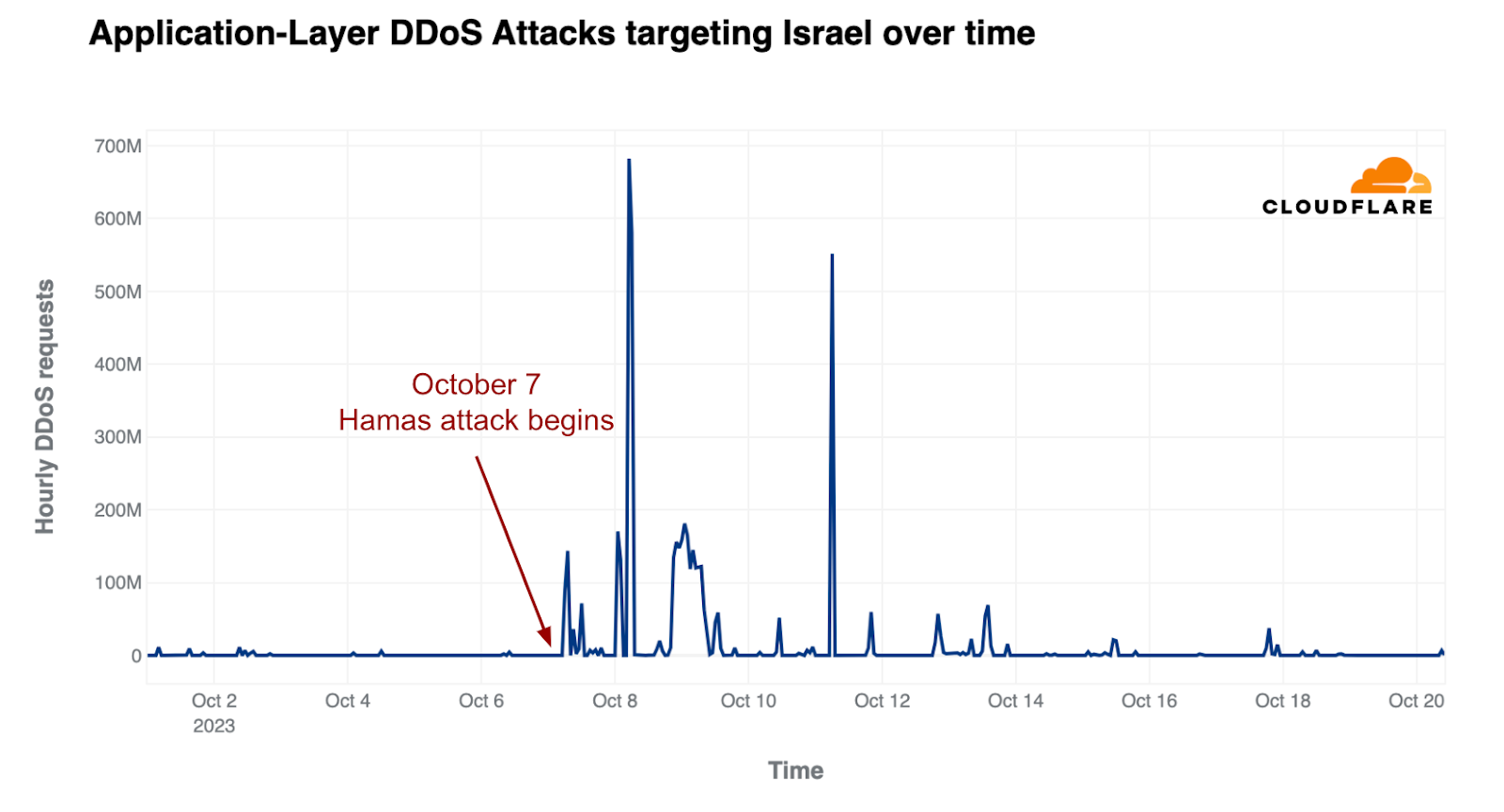
The global DDoS threat landscape
In the third quarter of 2023, Cloudflare faced one of the most sophisticated and persistent DDoS attack campaigns in recorded history.
- Cloudflare mitigated thousands of hyper-volumetric HTTP DDoS attacks, 89 of which exceeded 100 million requests per second (rps) and with the largest peaking at 201 million rps — a figure three times higher than the previous largest attack on record (71M rps).
- The campaign contributed to an overall increase of 65% in HTTP DDoS attack traffic in Q3 compared to the previous quarter. Similarly, L3/4 DDoS attacks also increased by 14%.
- Gaming and Gambling companies were bombarded with the largest volume of HTTP DDoS attack traffic, overtaking the Cryptocurrency industry from last quarter.
Reminder: an interactive version of this report is also available as a Cloudflare Radar Report. On Radar, you can also dive deeper and explore traffic trends, attacks, outages and many more insights for your specific industry, network and country.
HTTP DDoS attacks and hyper-volumetric attacks
An HTTP DDoS attack is a DDoS attack over the Hypertext Transfer Protocol (HTTP). It targets HTTP Internet properties such as mobile application servers, ecommerce websites, and API gateways.

HTTP/2, which accounts for 62% of HTTP traffic, is a version of the protocol that’s meant to improve application performance. The downside is that HTTP/2 can also help improve a botnet’s performance.

Campaign of hyper-volumetric DDoS attacks exploiting HTTP/2 Rapid Resets
Starting in late August 2023, Cloudflare and various other vendors were subject to a sophisticated and persistent DDoS attack campaign that exploited the HTTP/2 Rapid Reset vulnerability (CVE-2023-44487).
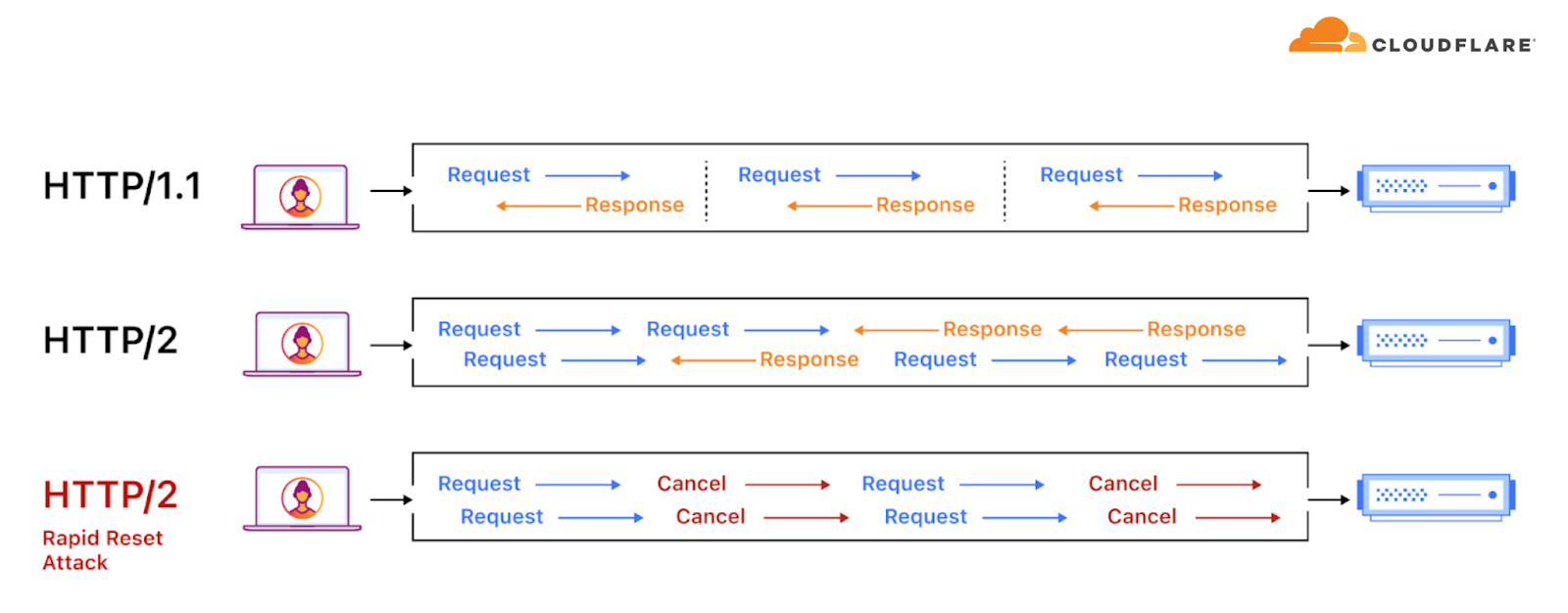
The DDoS campaign included thousands of hyper-volumetric DDoS attacks over HTTP/2 that peaked in the range of millions of requests per second. The average attack rate was 30M rps. Approximately 89 of the attacks peaked above 100M rps and the largest one we saw hit 201M rps.

Cloudflare’s systems automatically detected and mitigated the vast majority of attacks. We deployed emergency countermeasures and improved our mitigation systems’ efficacy and efficiency to ensure the availability of our network and of our customers’.
Check out our engineering blog that dives deep into the land of HTTP/2, what we learned and what actions we took to make the Internet safer.
Hyper-volumetric DDoS attacks enabled by VM-based botnets
As we’ve seen in this campaign and previous ones, botnets that leverage cloud computing platforms and exploit HTTP/2 are able to generate up to x5,000 more force per botnet node. This allowed them to launch hyper-volumetric DDoS attacks with a small botnet ranging 5-20 thousand nodes alone. To put that into perspective, in the past, IoT based botnets consisted of fleets of millions of nodes and barely managed to reach a few million requests per second.
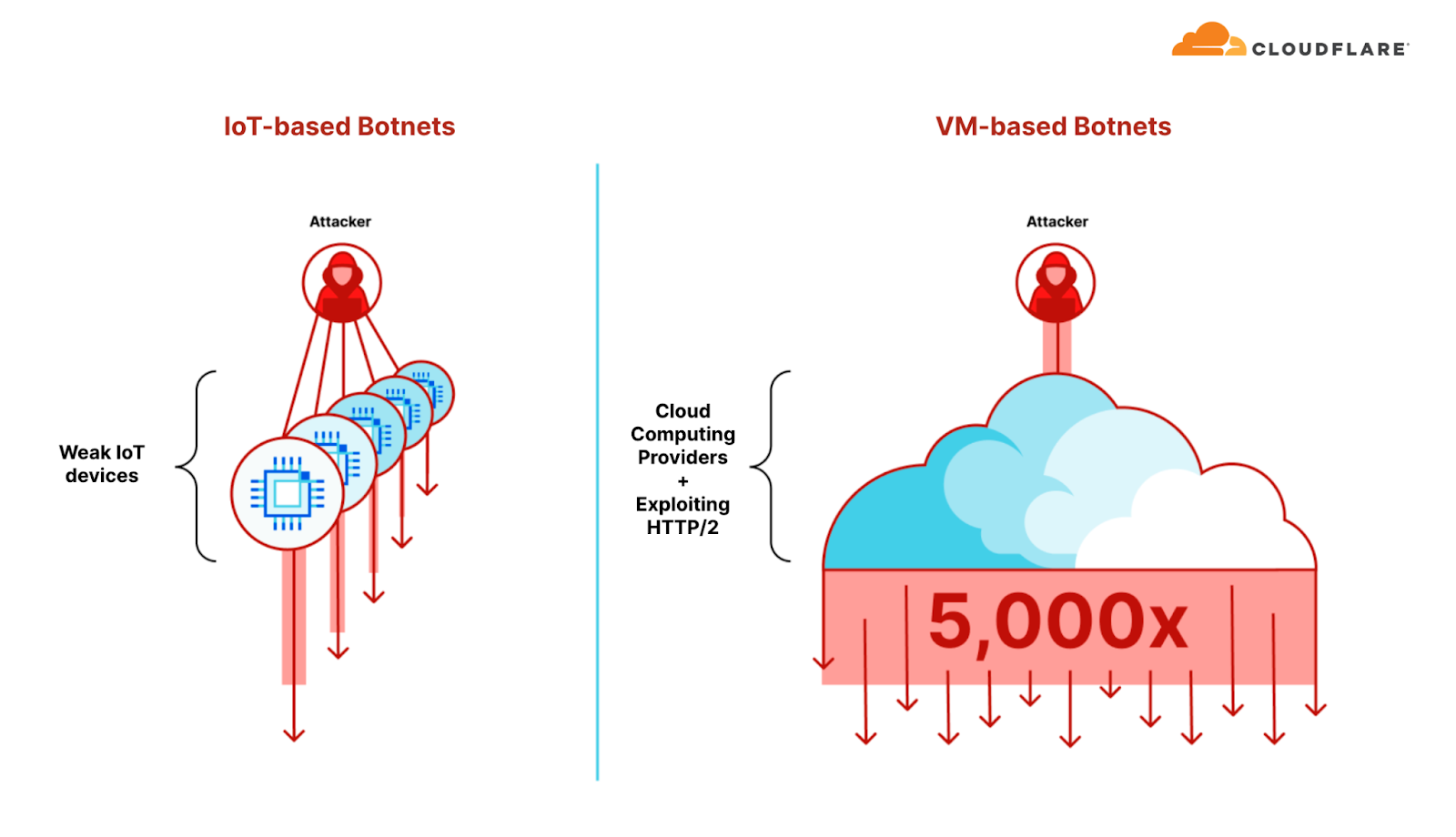
When analyzing the two-month-long DDoS campaign, we can see that Cloudflare infrastructure was the main target of the attacks. More specifically, 19% of all attacks targeted Cloudflare websites and infrastructure. Another 18% targeted Gaming companies, and 10% targeted well known VoIP providers.
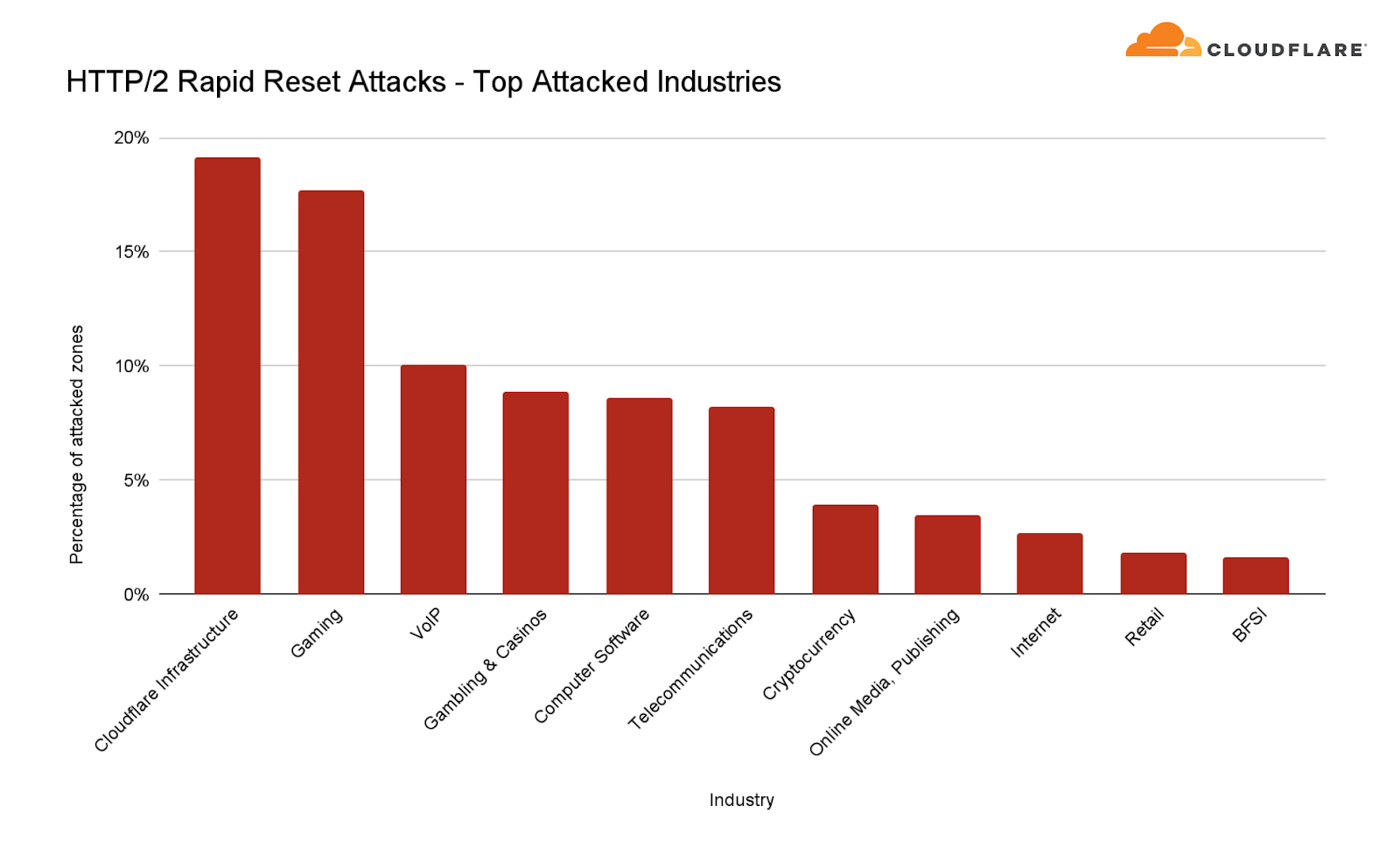
HTTP DDoS attack traffic increased by 65%
The attack campaign contributed to an overall increase in the amount of attack traffic. Last quarter, the volume of HTTP DDoS attacks increased by 15% QoQ. This quarter, it grew even more. Attacks volume increased by 65% QoQ to a total staggering figure of 8.9 trillion HTTP DDoS requests that Cloudflare systems automatically detected and mitigated.

Alongside the 65% increase in HTTP DDoS attacks, we also saw a minor increase of 14% in L3/4 DDoS attacks — similar to the figures we saw in the first quarter of this year.
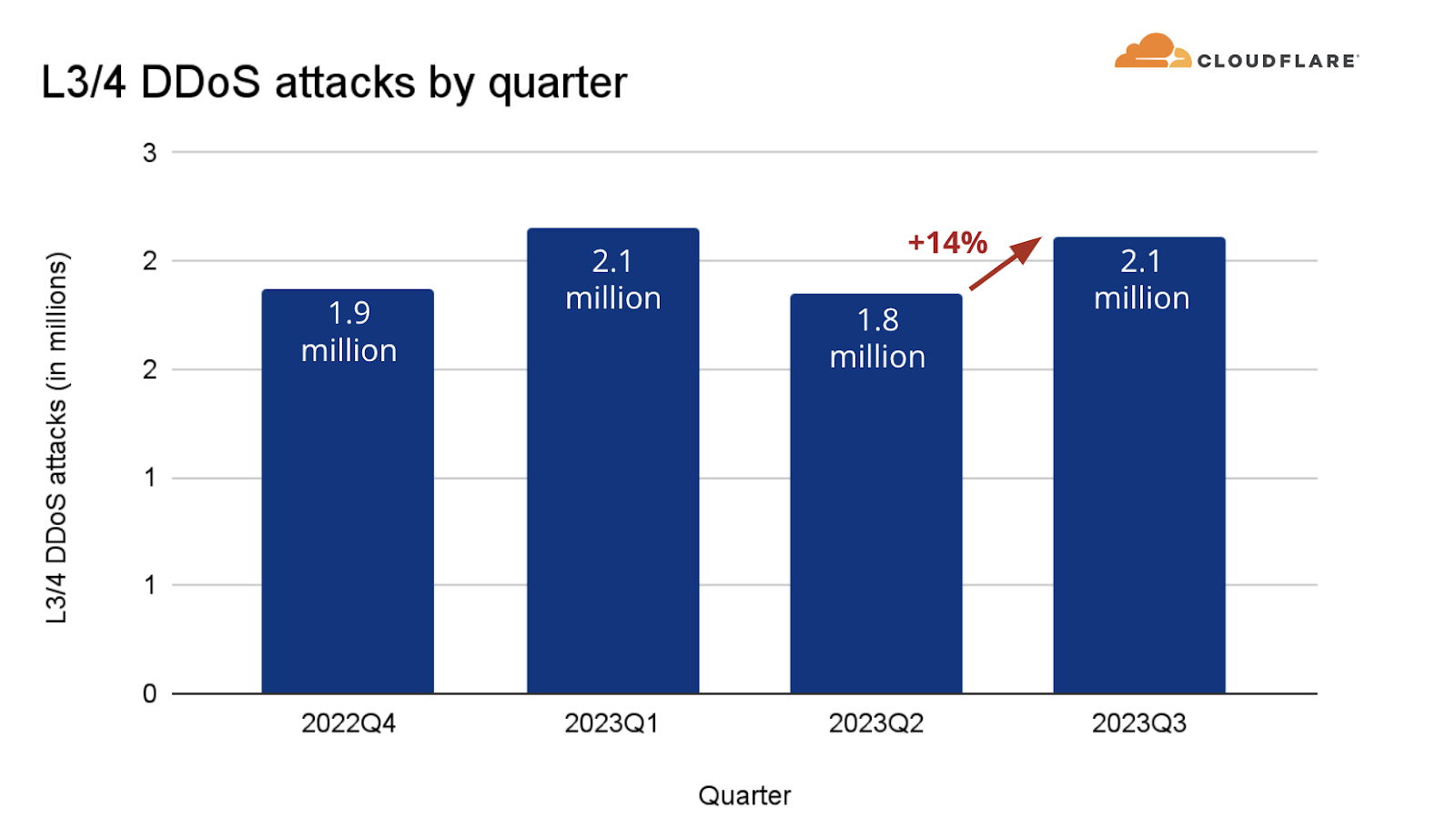
Top sources of HTTP DDoS attacks
When comparing the global and country-specific HTTP DDoS attack request volume, we see that the US remains the largest source of HTTP DDoS attacks. One out of every 25 HTTP DDoS requests originated from the US. China remains in second place. Brazil replaced Germany as the third-largest source of HTTP DDoS attacks, as Germany fell to fourth place.
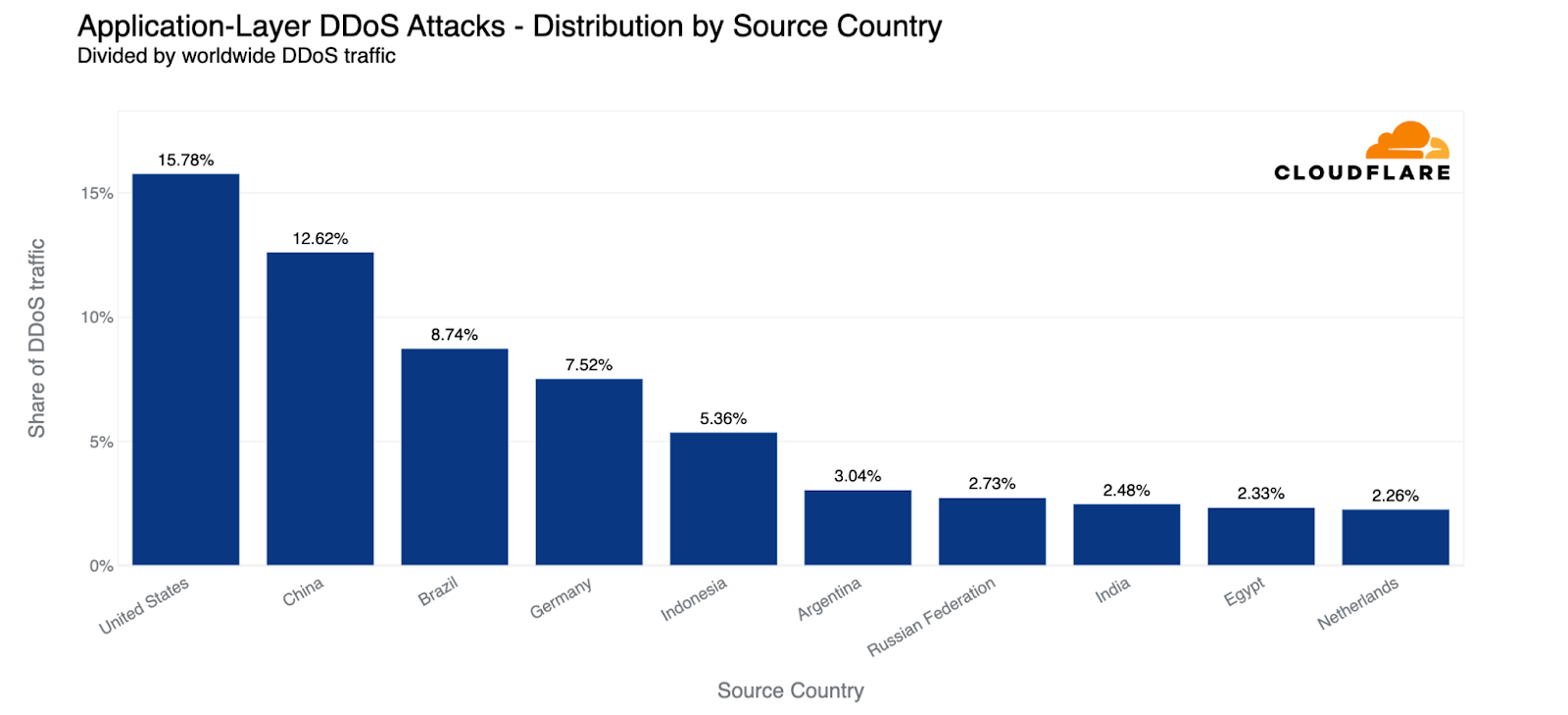
Some countries naturally receive more traffic due to various factors such as the population and Internet usage, and therefore also receive/generate more attacks. So while it’s interesting to understand the total amount of attack traffic originating from or targeting a given country, it is also helpful to remove that bias by normalizing the attack traffic by all traffic to a given country.
When doing so, we see a different pattern. The US doesn’t even make it into the top ten. Instead, Mozambique is in first place (again). One out of every five HTTP requests that originated from Mozambique was part of an HTTP DDoS attack traffic.
Egypt remains in second place — approximately 13% of requests originating from Egypt were part of an HTTP DDoS attack. Libya and China follow as the third and fourth-largest source of HTTP DDoS attacks.
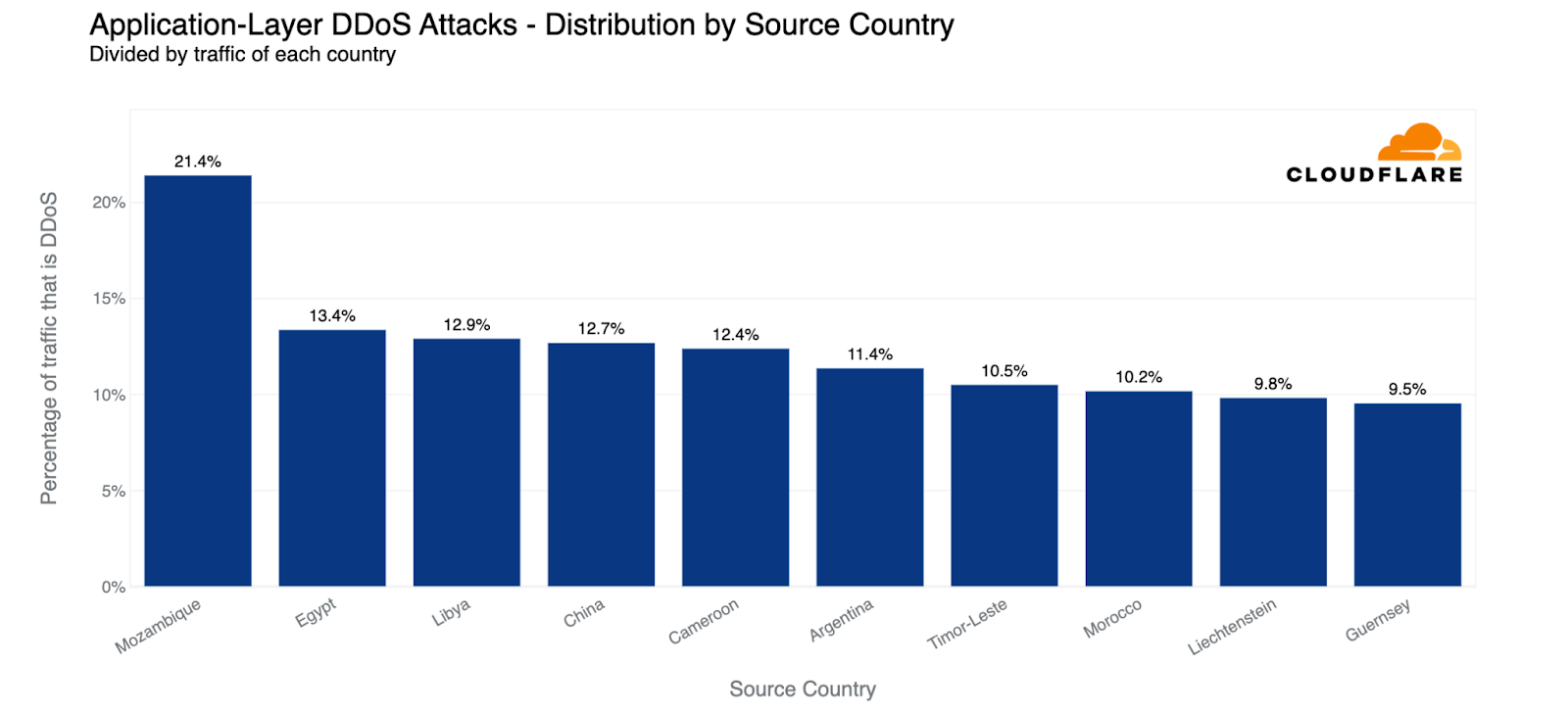
Top sources of L3/4 DDoS attacks
When we look at the origins of L3/4 DDoS attacks, we ignore the source IP address because it can be spoofed. Instead, we rely on the location of Cloudflare’s data center where the traffic was ingested. Thanks to our large network and global coverage, we’re able to achieve geographical accuracy to understand where attacks come from.
In Q3, approximately 36% of all L3/4 DDoS attack traffic that we saw in Q3 originated from the US. Far behind, Germany came in second place with 8% and the UK followed in third place with almost 5%.
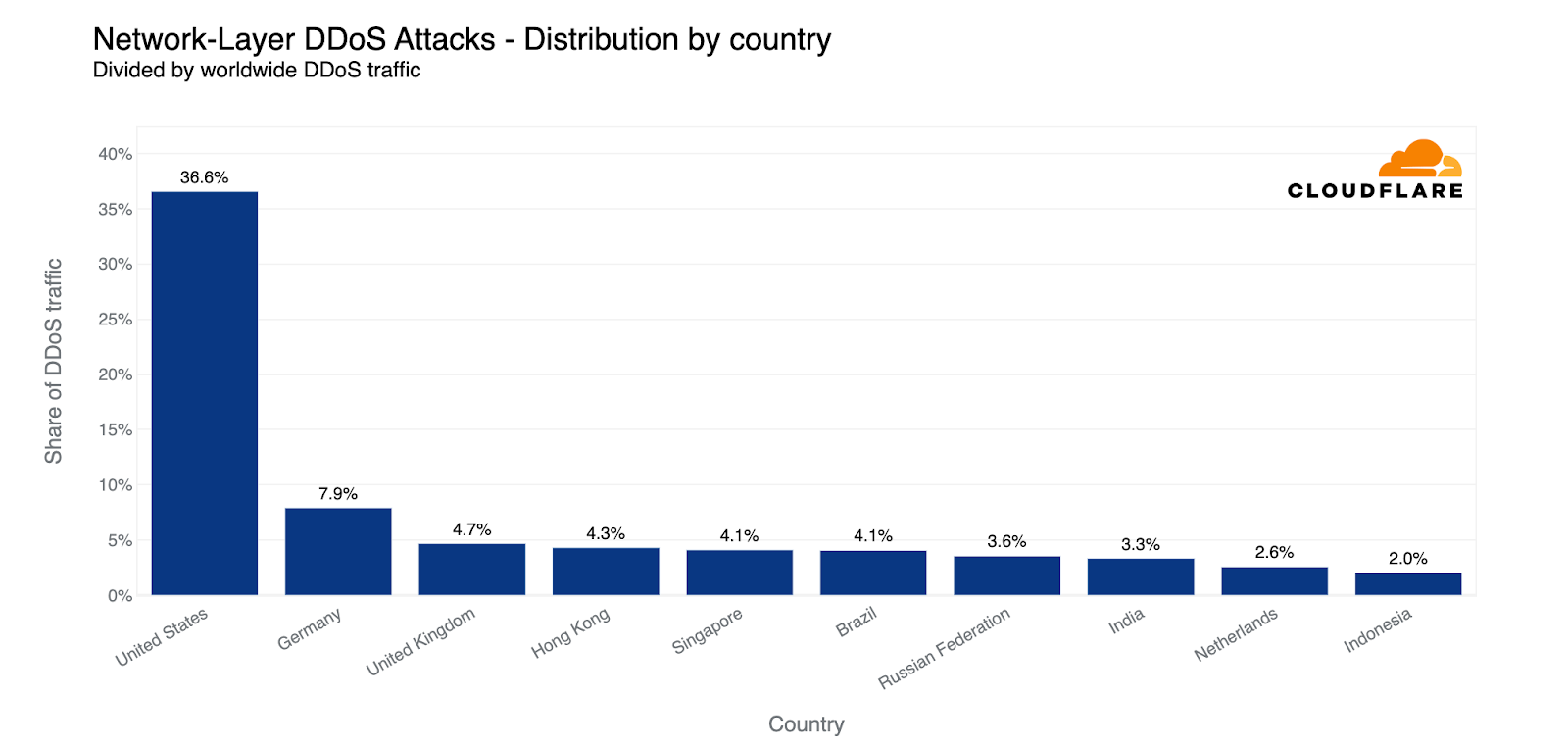
When normalizing the data, we see that Vietnam dropped to the second-largest source of L3/4 DDoS attacks after being first for two consecutive quarters. New Caledonia, a French territory comprising dozens of islands in the South Pacific, grabbed the first place. Two out of every four bytes ingested in Cloudflare’s data centers in New Caledonia were attacks.
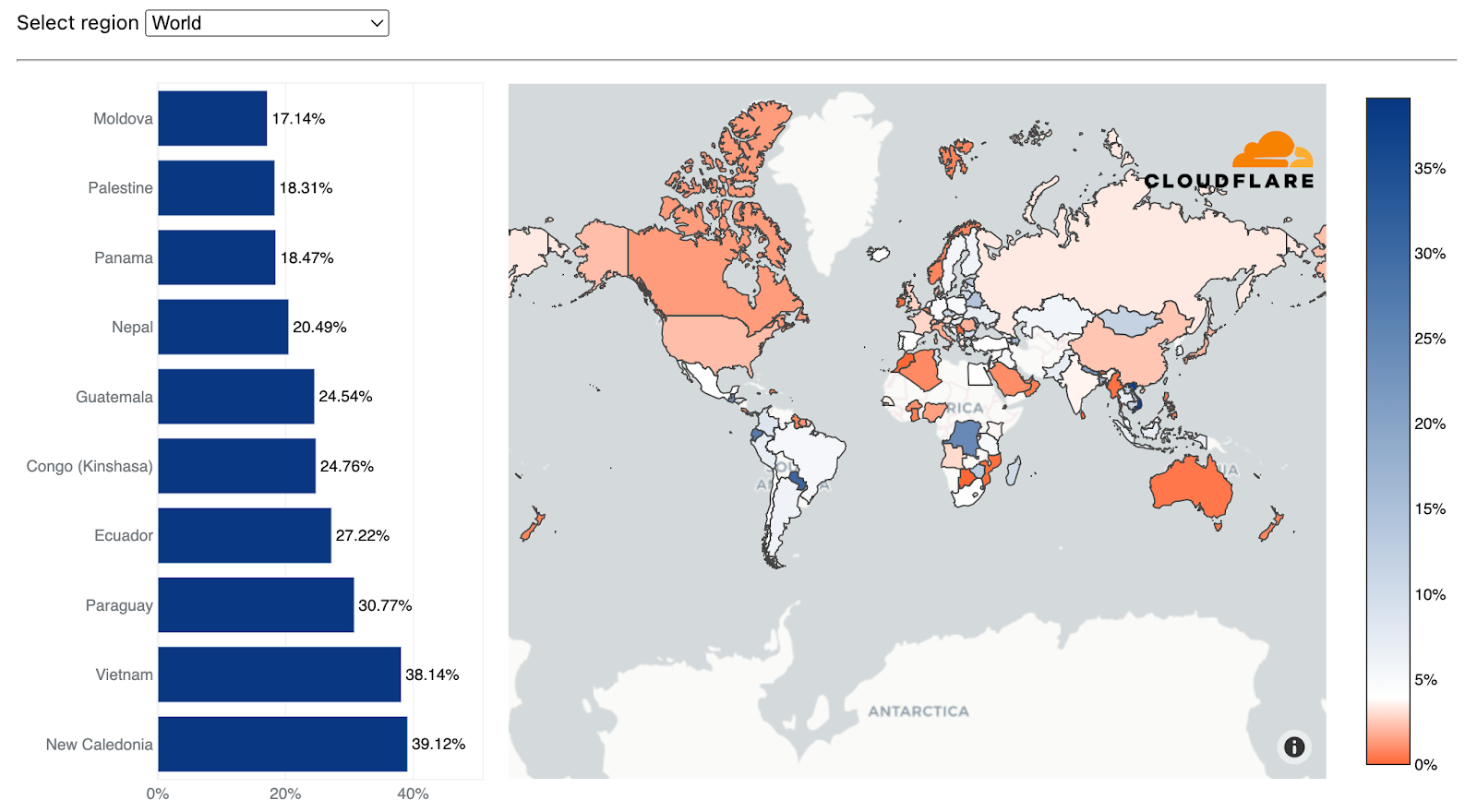
Top attacked industries by HTTP DDoS attacks
In terms of absolute volume of HTTP DDoS attack traffic, the Gaming and Gambling industry jumps to first place overtaking the Cryptocurrency industry. Over 5% of all HTTP DDoS attack traffic that Cloudflare saw targeted the Gaming and Gambling industry.
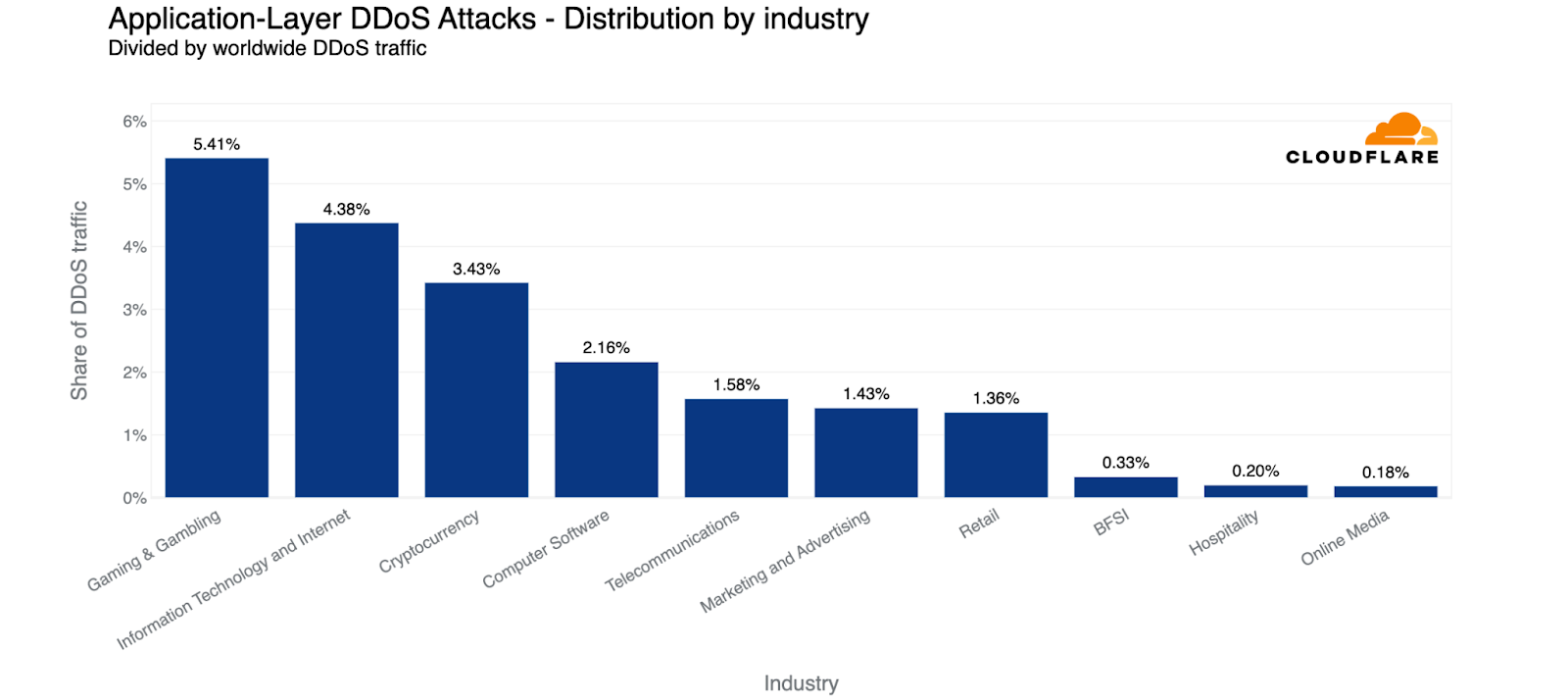
The Gaming and Gambling industry has long been one of the most attacked industries compared to others. But when we look at the HTTP DDoS attack traffic relative to each specific industry, we see a different picture. The Gaming and Gambling industry has so much user traffic that, despite being the most attacked industry by volume, it doesn’t even make it into the top ten when we put it into the per-industry context.
Instead, what we see is that the Mining and Metals industry was targeted by the most attacks compared to its total traffic — 17.46% of all traffic to Mining and Metals companies were DDoS attack traffic.
Following closely in second place, 17.41% of all traffic to Non-profits were HTTP DDoS attacks. Many of these attacks are directed at more than 2,400 Non-profit and independent media organizations in 111 countries that Cloudflare protects for free as part of Project Galileo, which celebrated its ninth anniversary this year. Over the past quarter alone, Cloudflare mitigated an average of 180.5 million cyber threats against Galileo-protected websites every day.
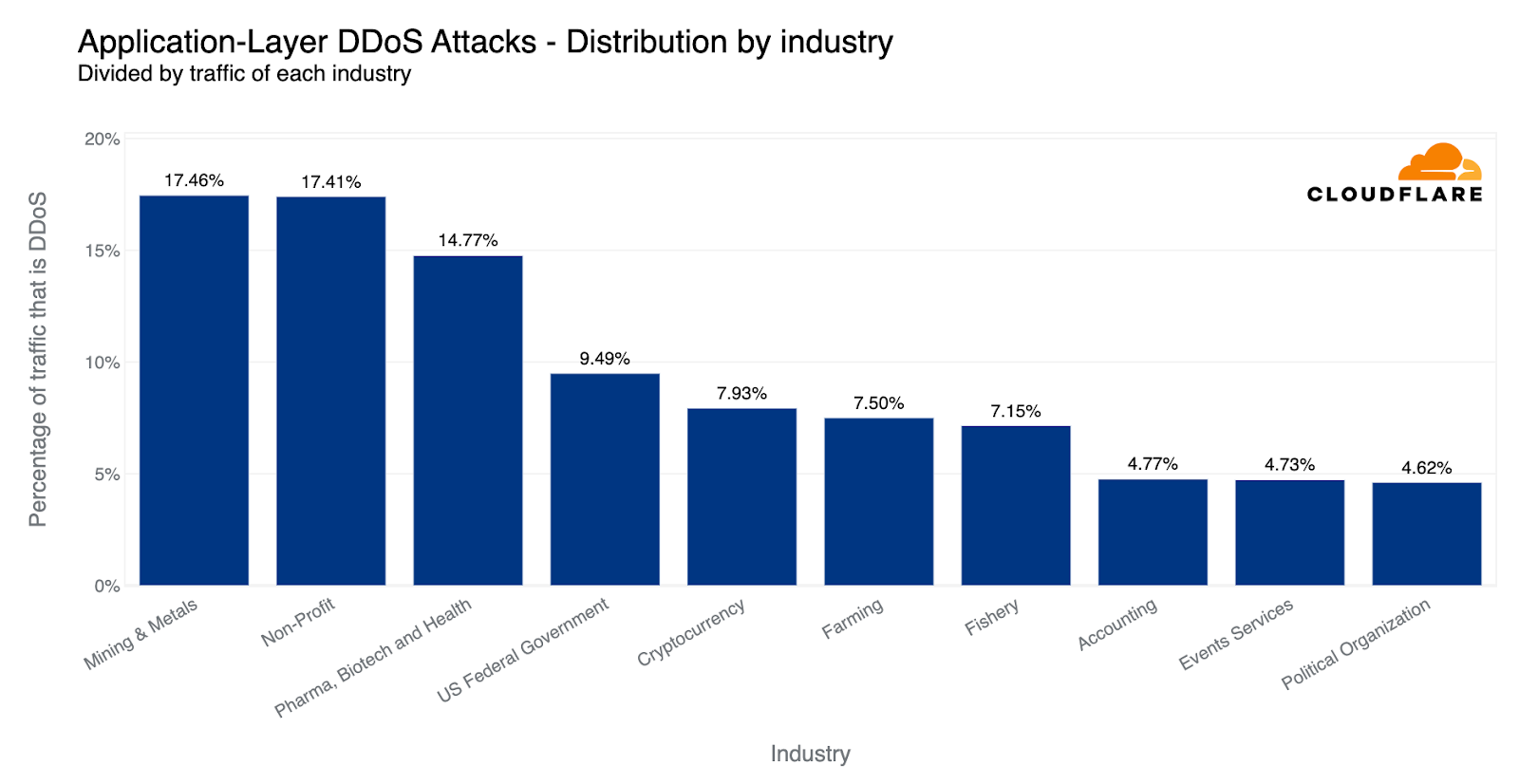
Pharmaceuticals, Biotechnology and Health companies came in third, and US Federal Government websites in fourth place. Almost one out of every 10 HTTP requests to US Federal Government Internet properties were part of an attack. In fifth place, Cryptocurrency and then Farming and Fishery not far behind.
Top attacked industries by region
Now let’s dive deeper to understand which industries were targeted the most in each region.
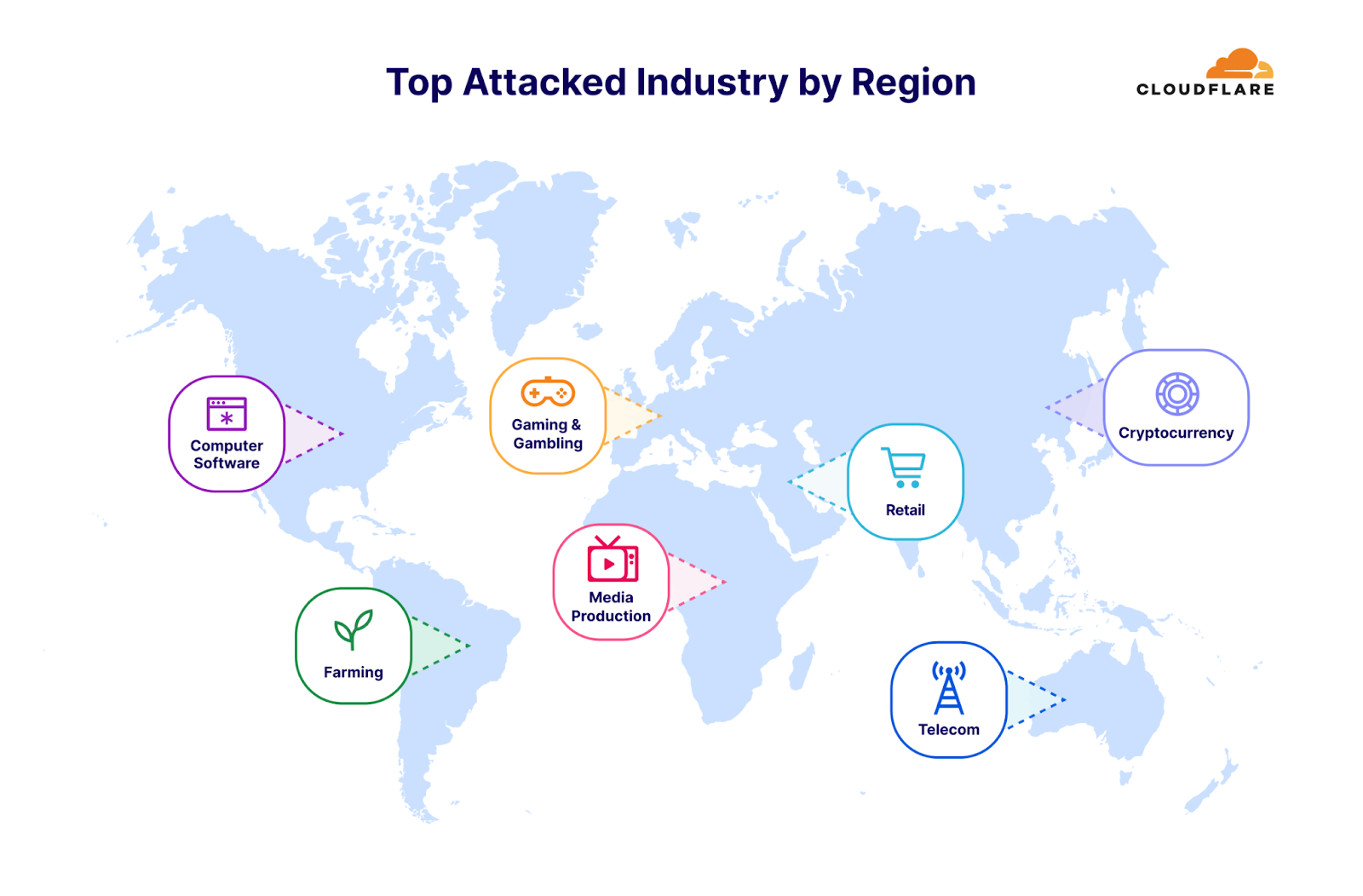
Regional deepdives
Africa
After two consecutive quarters as the most attacked industry, the Telecommunications industry dropped from first place to fourth. Media Production companies were the most attacked industry in Africa. The Banking, Financial Services and Insurance (BFSI) industry follows as the second most attacked. Gaming and Gambling companies in third.
Asia
The Cryptocurrency industry remains the most attacked in APAC for the second consecutive quarter. Gaming and Gambling came in second place. Information Technology and Services companies in third.
Europe
For the fourth consecutive quarter, the Gaming and Gambling industry remains the most attacked industry in Europe. Retail companies came in second, and Computer Software companies in third.
Latin America
Farming was the most targeted industry in Latin America in Q3. It accounted for a whopping 53% of all attacks towards Latin America. Far behind, Gaming and Gambling companies were the second most targeted. Civic and Social Organizations were in third.
Middle East
Retail companies were the most targeted in the Middle East in Q3. Computer Software companies came in second and the Gaming and Gambling industry in third.
North America
After two consecutive quarters, the Marketing and Advertising industry dropped from the first place to the second. Computer Software took the lead. In third place, Telecommunications companies.
Oceania
The Telecommunications industry was, by far, the most targeted in Oceania in Q3 — over 45% of all attacks to Oceania. Cryptocurrency and Computer Software companies came in second and third places respectively.
Top attacked industries by L3/4 DDoS attacks
When descending the layers of the OSI model, the Internet networks and services that were most targeted belonged to the Information Technology and Services industry. Almost 35% of all L3/4 DDoS attack traffic (in bytes) targeted the Information Technology and Internet industry.
Far behind, Telecommunication companies came in second with a mere share of 3%. Gaming and Gambling came in third, Banking, Financial Services and Insurance companies (BFSI) in fourth.
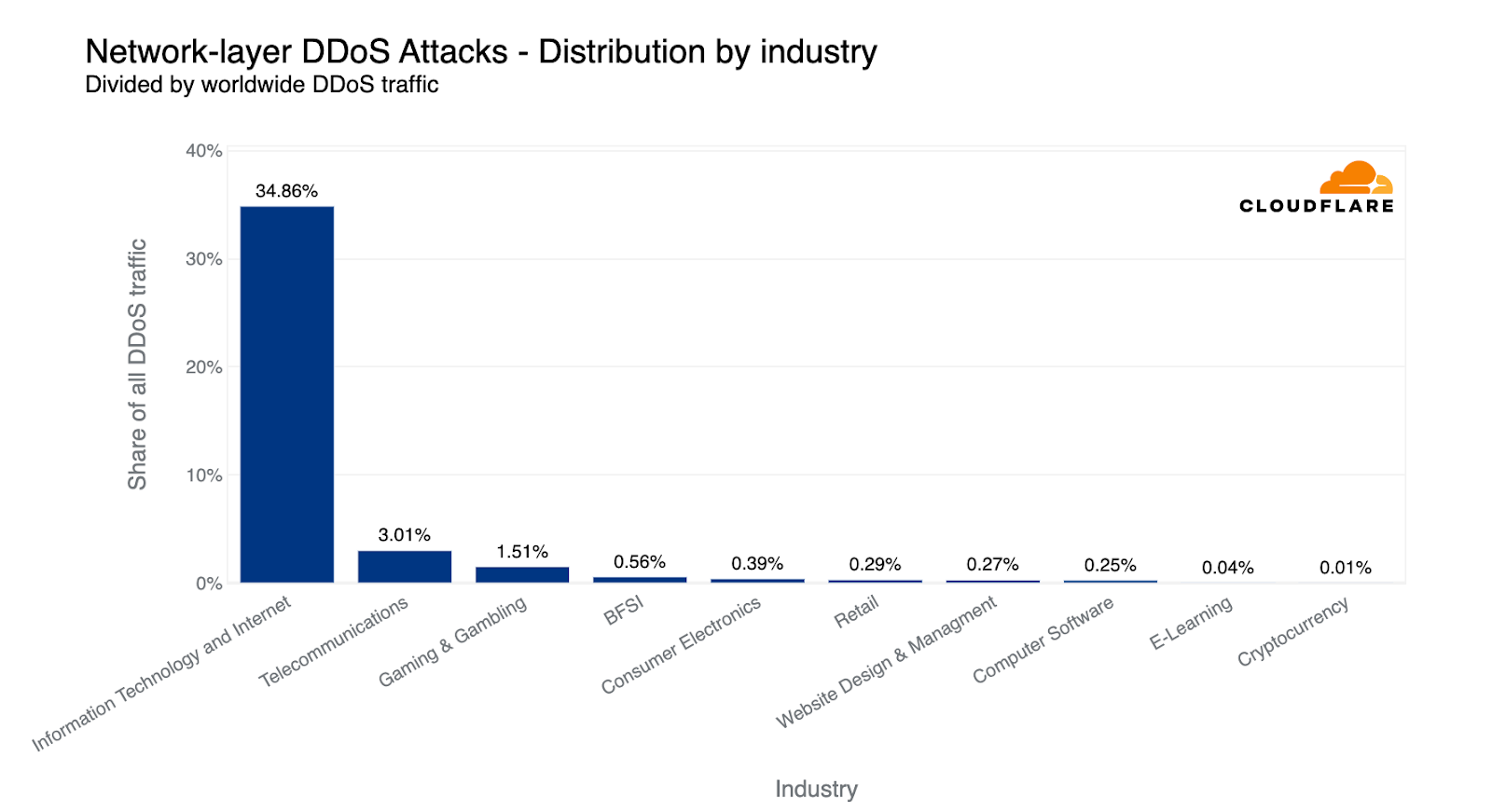
When comparing the attacks on industries to all traffic for that specific industry, we see that the Music industry jumps to the first place, followed by Computer and Network Security companies, Information Technology and Internet companies and Aviation and Aerospace.
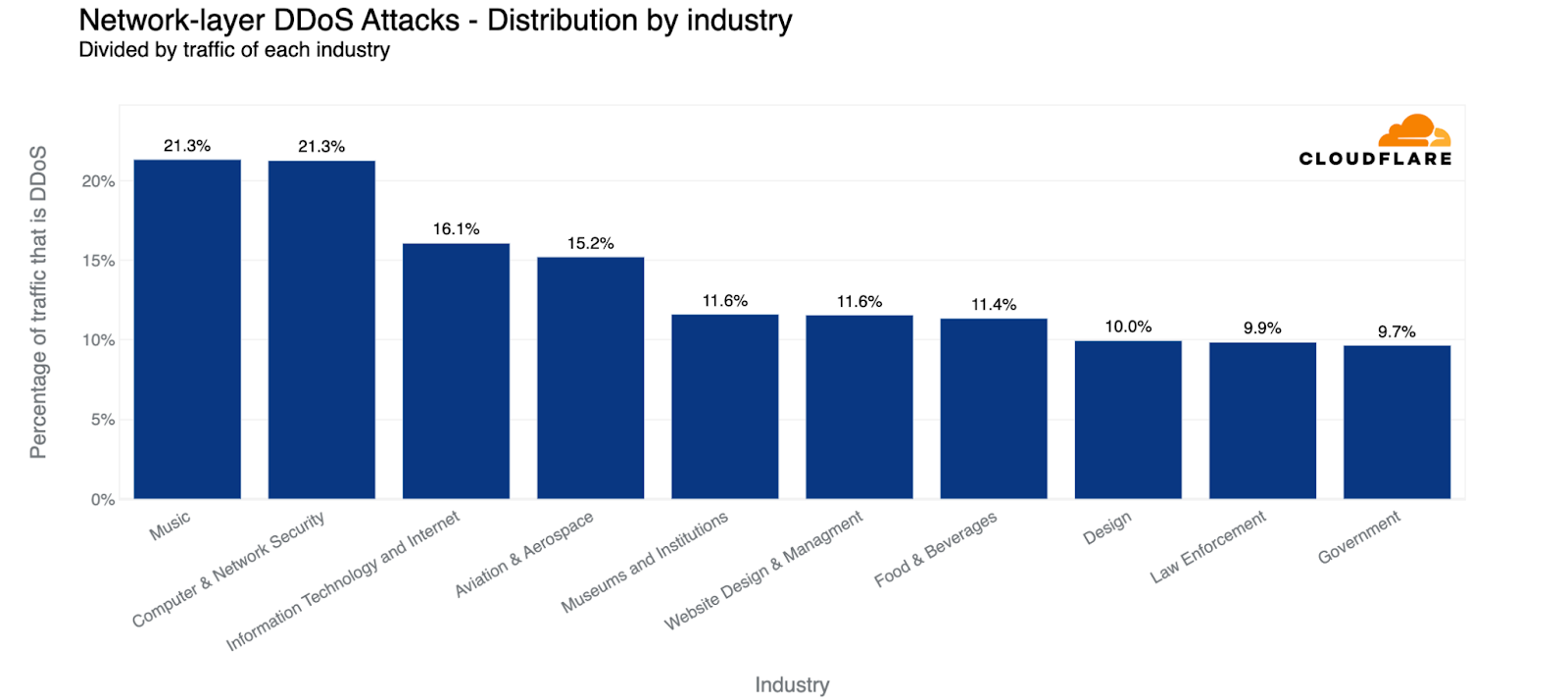
Top attacked countries by HTTP DDoS attacks
When examining the total volume of attack traffic, the US remains the main target of HTTP DDoS attacks. Almost 5% of all HTTP DDoS attack traffic targeted the US. Singapore came in second and China in third.
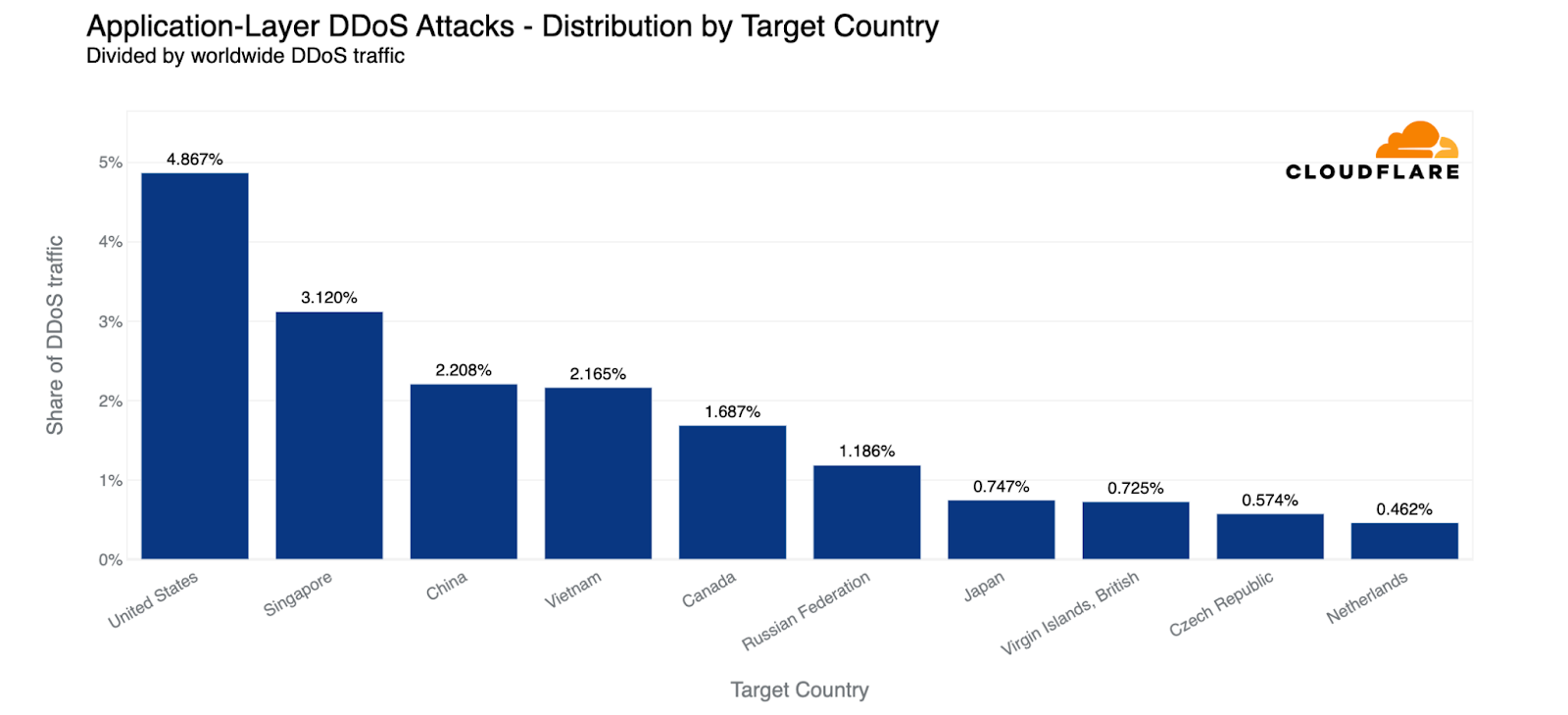
If we normalize the data per country and region and divide the attack traffic by the total traffic, we get a different picture. The top three most attacked countries are Island nations.
Anguilla, a small set of islands east of Puerto Rico, jumps to the first place as the most attacked country. Over 75% of all traffic to Anguilla websites were HTTP DDoS attacks. In second place, American Samoa, a group of islands east of Fiji. In third, the British Virgin Islands.
In fourth place, Algeria, and then Kenya, Russia, Vietnam, Singapore, Belize, and Japan.
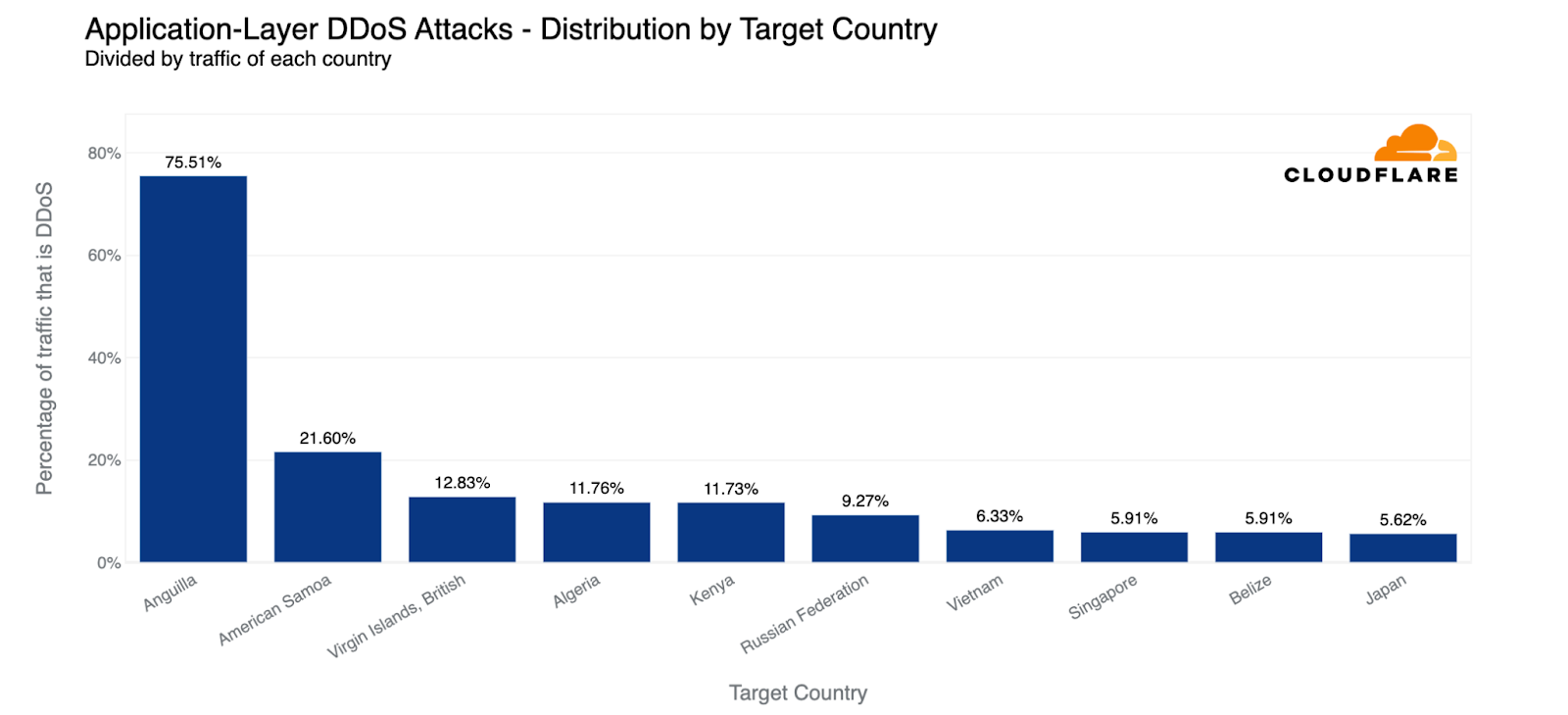
Top attacked countries by L3/4 DDoS attacks
For the second consecutive quarter, Chinese Internet networks and services remain the most targeted by L3/4 DDoS attacks. These China-bound attacks account for 29% of all attacks we saw in Q3.
Far, far behind, the US came in second place (3.5%) and Taiwan in third place (3%).
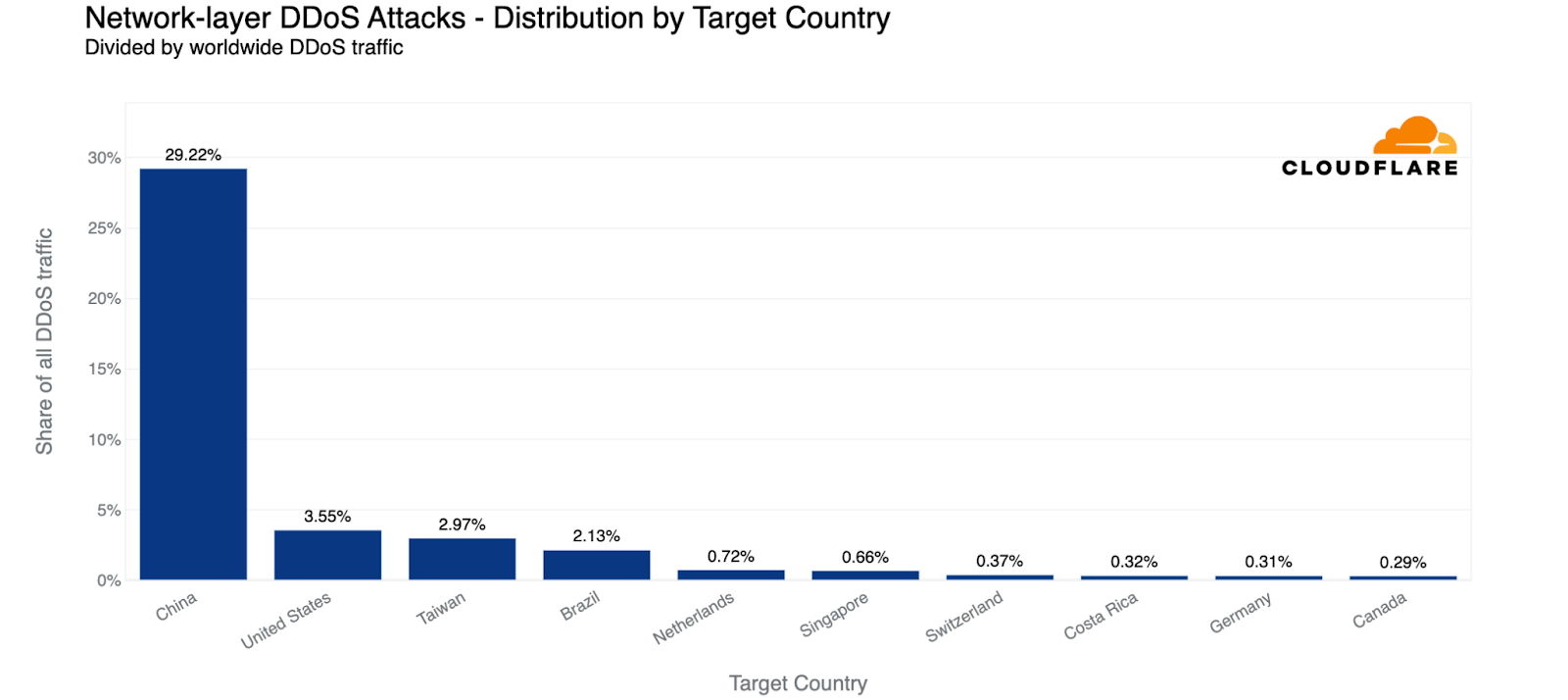
When normalizing the amount of attack traffic compared to all traffic to a country, China remains in first place and the US disappears from the top ten. Cloudflare saw that 73% of traffic to China Internet networks were attacks. However, the normalized ranking changes from second place on, with the Netherlands receiving the second-highest proportion of attack traffic (representing 35% of the country’s overall traffic), closely followed by Thailand, Taiwan and Brazil.
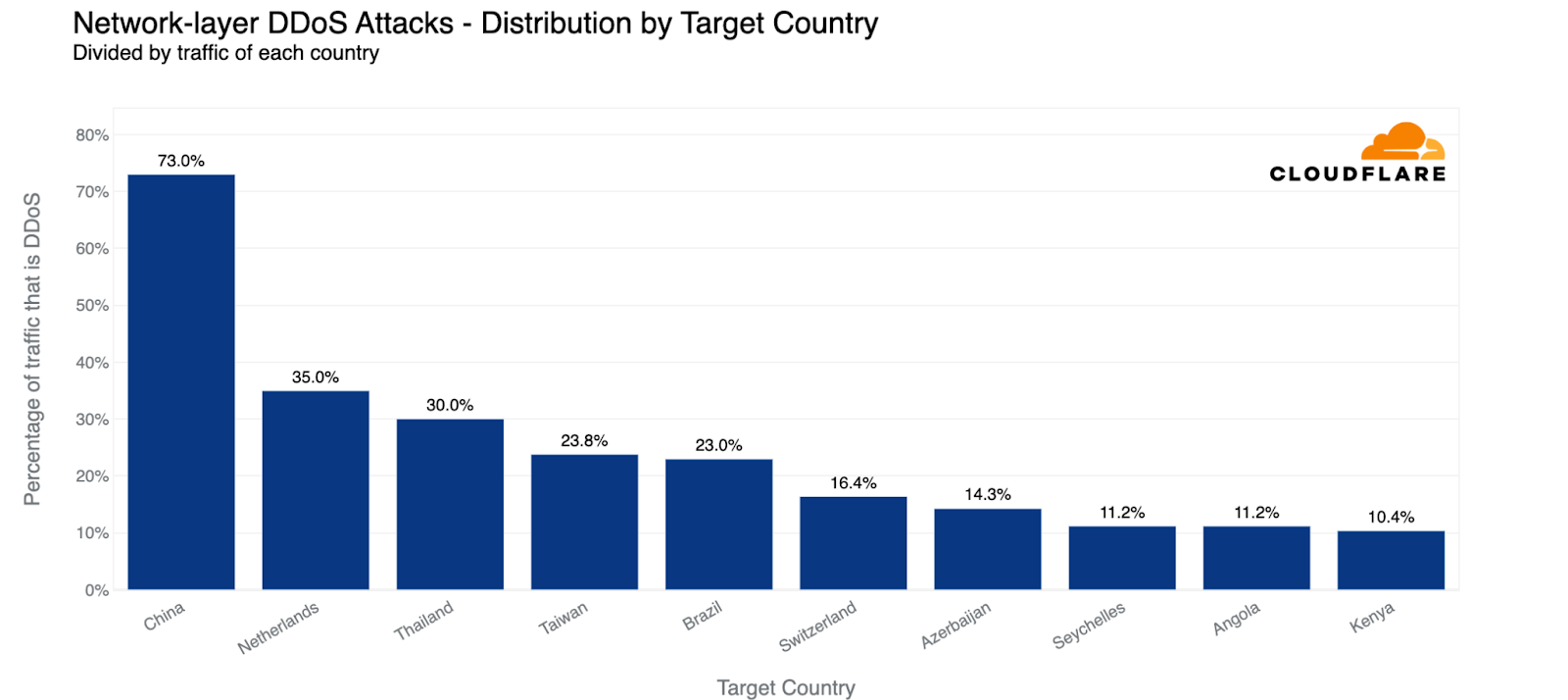
Top attack vectors
The Domain Name System, or DNS, serves as the phone book of the Internet. DNS helps translate the human-friendly website address (e.g., www.cloudflare.com) to a machine-friendly IP address (e.g., 104.16.124.96). By disrupting DNS servers, attackers impact the machines’ ability to connect to a website, and by doing so making websites unavailable to users.
For the second consecutive quarter, DNS-based DDoS attacks were the most common. Almost 47% of all attacks were DNS-based. This represents a 44% increase compared to the previous quarter. SYN floods remain in second place, followed by RST floods, UDP floods, and Mirai attacks.
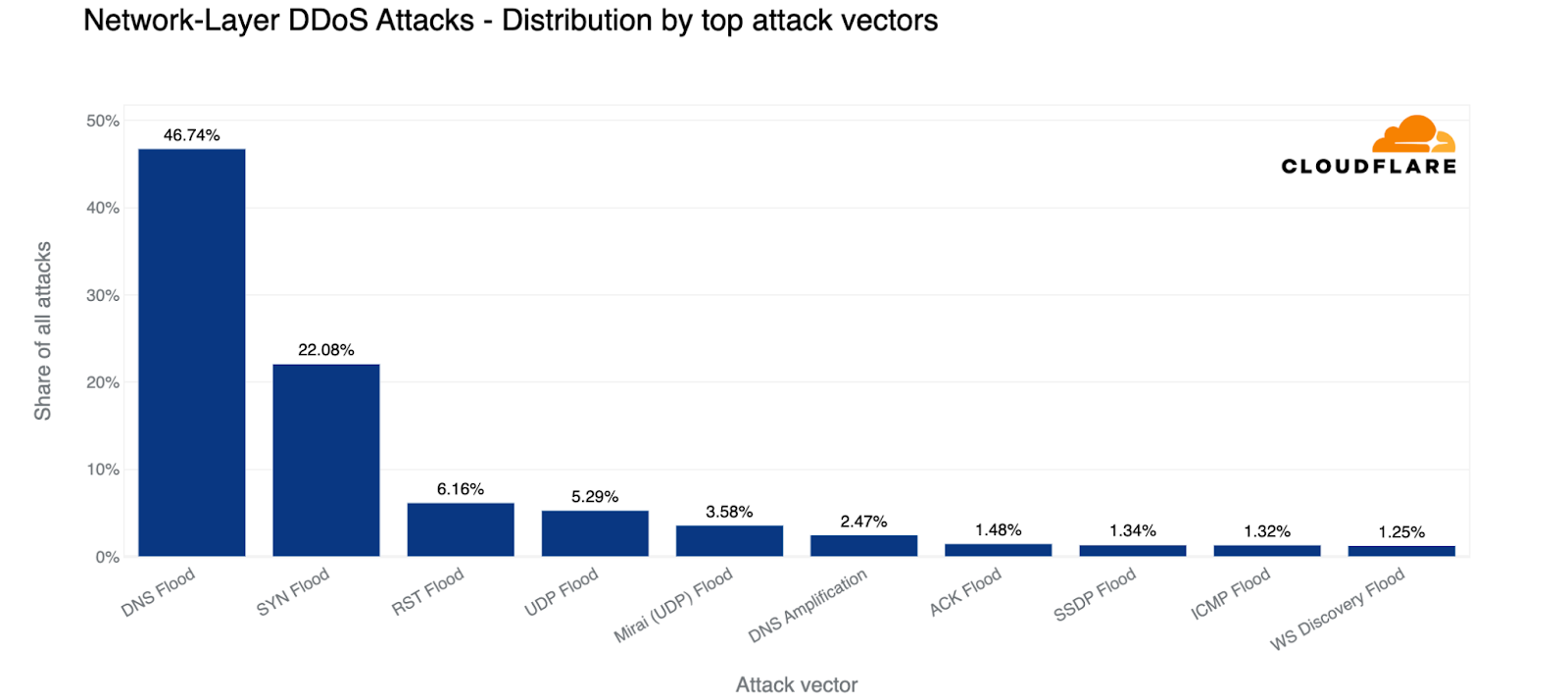
Emerging threats - reduced, reused and recycled
Aside from the most common attack vectors, we also saw significant increases in lesser known attack vectors. These tend to be very volatile as threat actors try to “reduce, reuse and recycle” older attack vectors. These tend to be UDP-based protocols that can be exploited to launch amplification and reflection DDoS attacks.
One well-known tactic that we continue to see is the use of amplification/reflection attacks. In this attack method, the attacker bounces traffic off of servers, and aims the responses towards their victim. Attackers are able to aim the bounced traffic to their victim by various methods such as IP spoofing.
Another form of reflection can be achieved differently in an attack named ‘DNS Laundering attack’. In a DNS Laundering attack, the attacker will query subdomains of a domain that is managed by the victim’s DNS server. The prefix that defines the subdomain is randomized and is never used more than once or twice in such an attack. Due to the randomization element, recursive DNS servers will never have a cached response and will need to forward the query to the victim’s authoritative DNS server. The authoritative DNS server is then bombarded by so many queries until it cannot serve legitimate queries or even crashes all together.
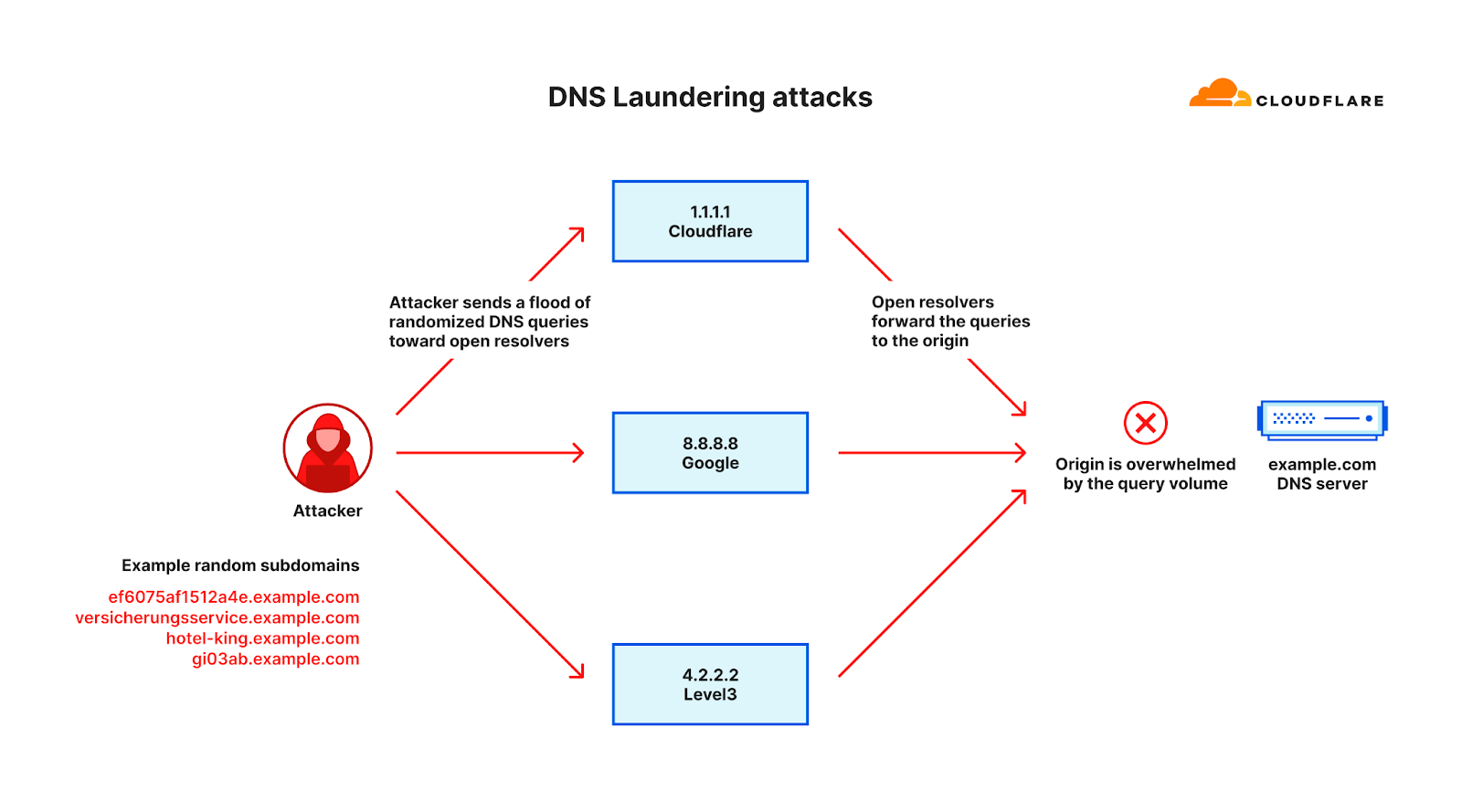
Overall in Q3, Multicast DNS (mDNS) based DDoS attacks was the attack method that increased the most. In second place were attacks that exploit the Constrained Application Protocol (CoAP), and in third, the Encapsulating Security Payload (ESP). Let’s get to know those attack vectors a little better.
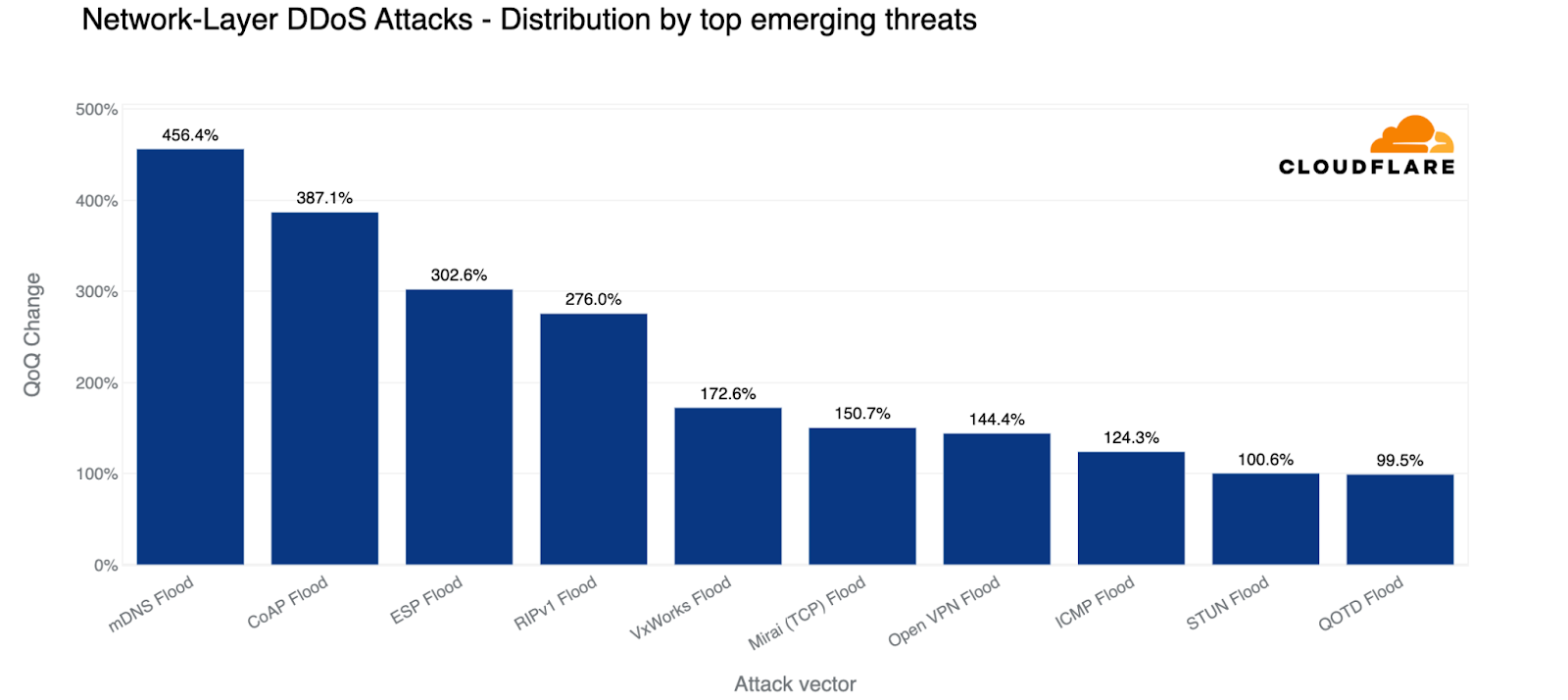
mDNS DDoS attacks increased by 456%
Multicast DNS (mDNS) is a UDP-based protocol that is used in local networks for service/device discovery. Vulnerable mDNS servers respond to unicast queries originating outside the local network, which are ‘spoofed’ (altered) with the victim's source address. This results in amplification attacks. In Q3, we noticed a large increase of mDNS attacks; a 456% increase compared to the previous quarter.
CoAP DDoS attacks increased by 387%
The Constrained Application Protocol (CoAP) is designed for use in simple electronics and enables communication between devices in a low-power and lightweight manner. However, it can be abused for DDoS attacks via IP spoofing or amplification, as malicious actors exploit its multicast support or leverage poorly configured CoAP devices to generate large amounts of unwanted network traffic. This can lead to service disruption or overloading of the targeted systems, making them unavailable to legitimate users.
ESP DDoS attacks increased by 303%
The Encapsulating Security Payload (ESP) protocol is part of IPsec and provides confidentiality, authentication, and integrity to network communications. However, it could potentially be abused in DDoS attacks if malicious actors exploit misconfigured or vulnerable systems to reflect or amplify traffic towards a target, leading to service disruption. Like with other protocols, securing and properly configuring the systems using ESP is crucial to mitigate the risks of DDoS attacks.
Ransom DDoS attacks
Occasionally, DDoS attacks are carried out to extort ransom payments. We’ve been surveying Cloudflare customers over three years now, and have been tracking the occurrence of Ransom DDoS attack events.
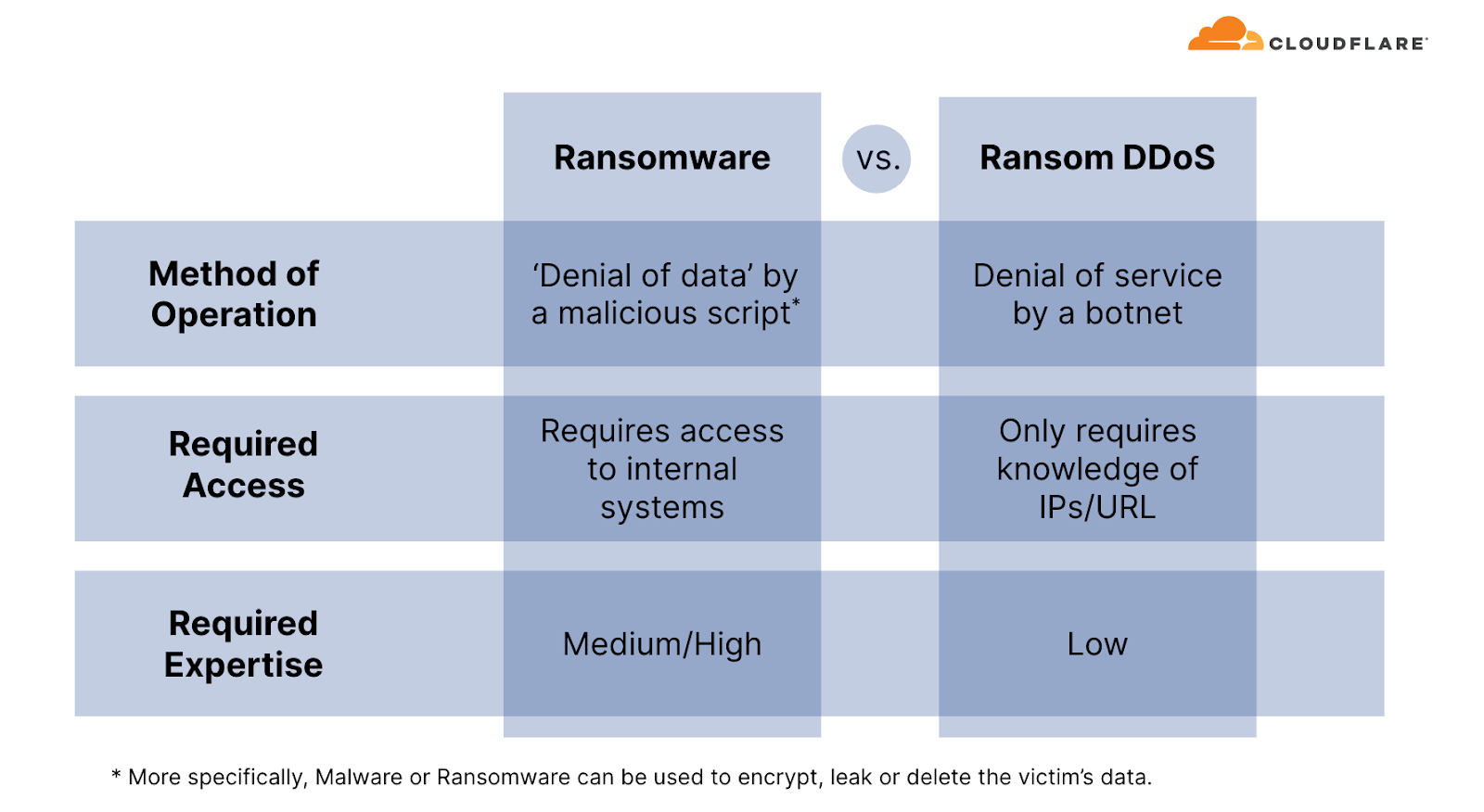
Unlike Ransomware attacks, where victims typically fall prey to downloading a malicious file or clicking on a compromised email link which locks, deletes, or leaks their files until a ransom is paid, Ransom DDoS attacks can be much simpler for threat actors to execute. Ransom DDoS attacks bypass the need for deceptive tactics such as luring victims into opening dubious emails or clicking on fraudulent links, and they don't necessitate a breach into the network or access to corporate resources.
Over the past quarter, reports of Ransom DDoS attacks continue to decrease. Approximately 8% of respondents reported being threatened or subject to Random DDoS attacks, which continues a decline we've been tracking throughout the year. This is a continued decline that we’ve been tracking throughout the year. Hopefully it is because threat actors have realized that organizations will not pay them (which is our recommendation).
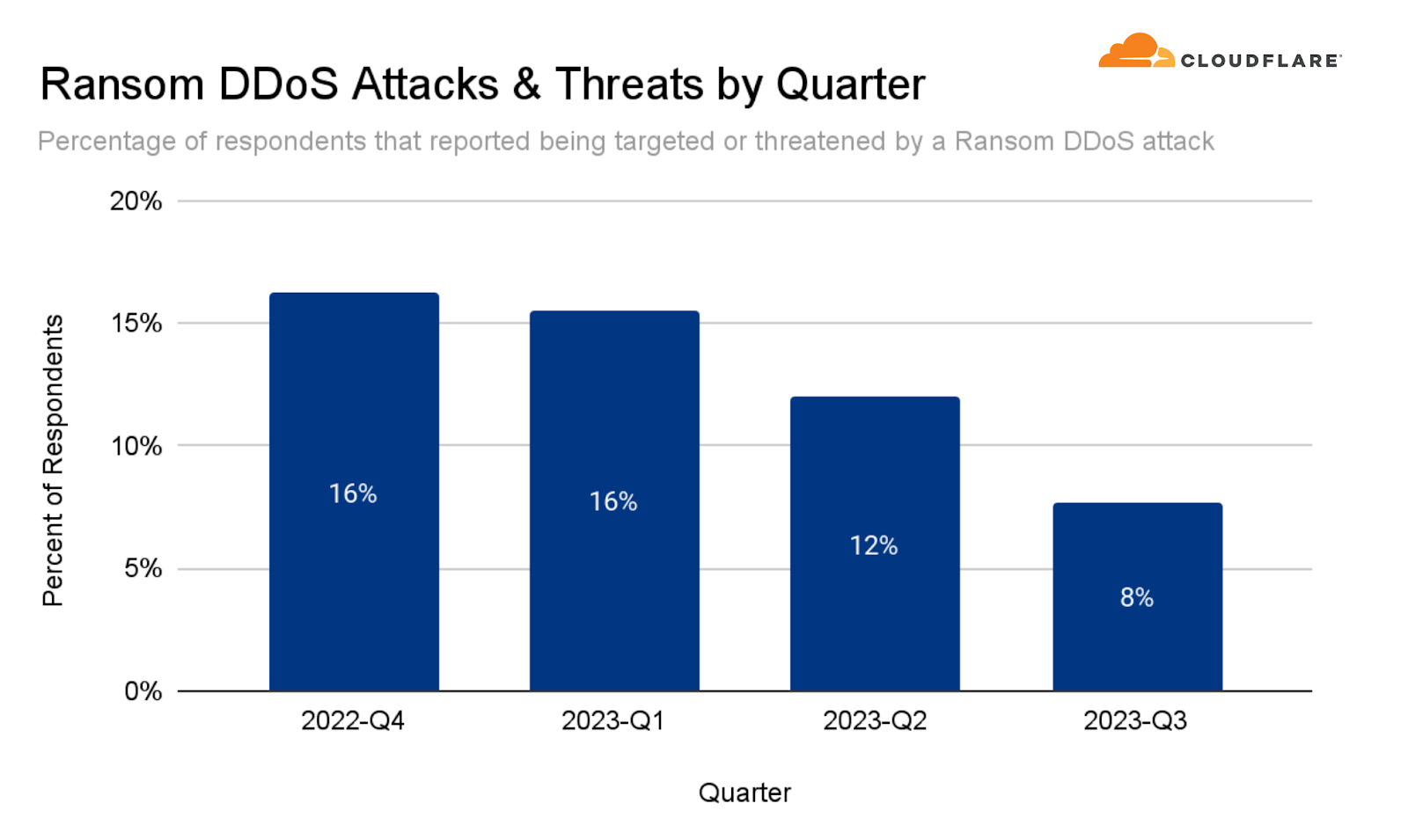
However, keep in mind that this is also very seasonal, and we can expect an increase in ransom DDoS attacks during the months of November and December. If we look at Q4 numbers from the past three years, we can see that Ransom DDoS attacks have been significantly increasing YoY in November. In previous Q4s, it reached a point where one out of every four respondents reported being subject to Ransom DDoS attacks.
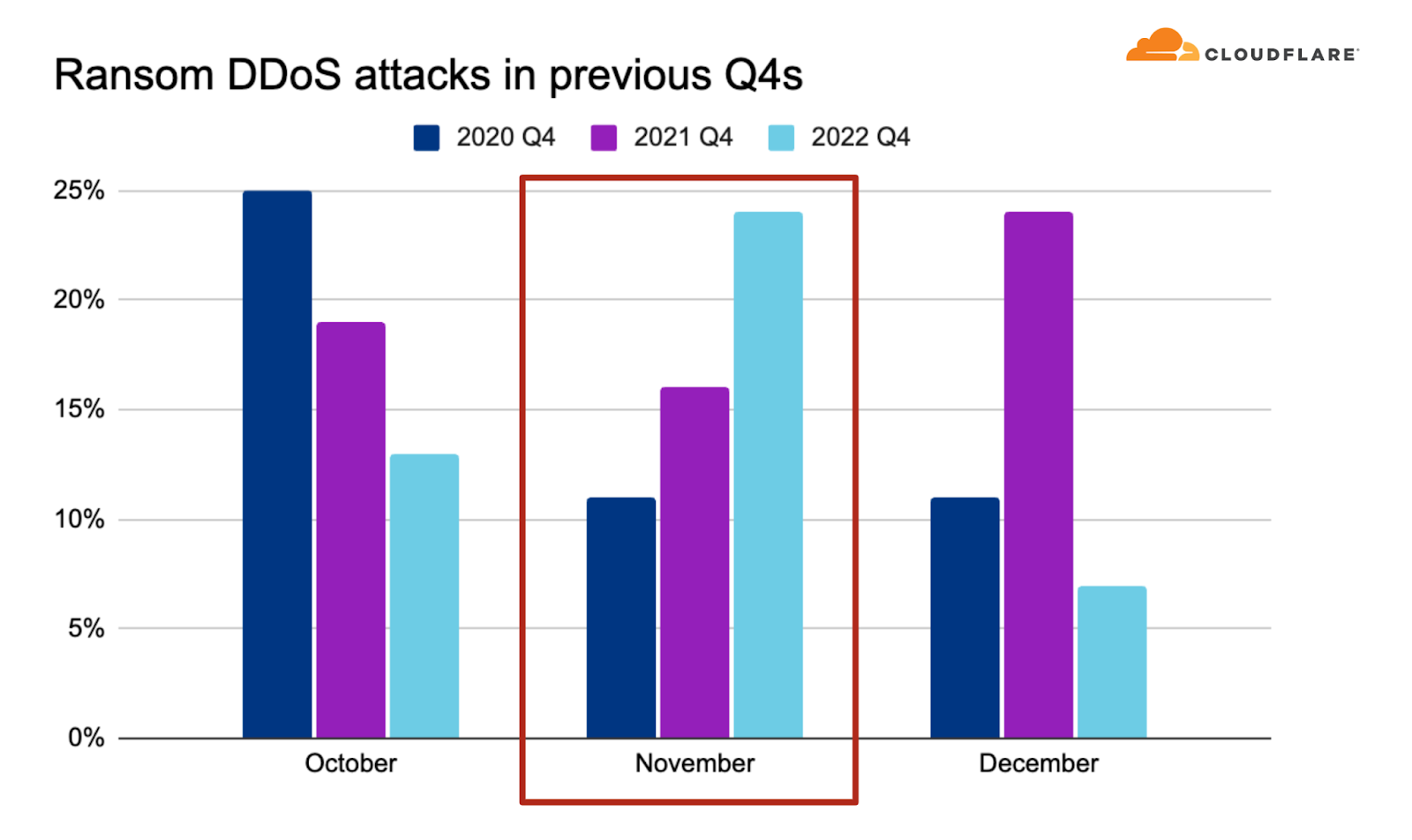
Improving your defenses in the era of hyper-volumetric DDoS attacks
In the past quarter, we saw an unprecedented surge in DDoS attack traffic. This surge was largely driven by the hyper-volumetric HTTP/2 DDoS attack campaign.
Cloudflare customers using our HTTP reverse proxy, i.e. our CDN/WAF services, are already protected from these and other HTTP DDoS attacks. Cloudflare customers that are using non-HTTP services and organizations that are not using Cloudflare at all are strongly encouraged to use an automated, always-on HTTP DDoS Protection service for their HTTP applications.
It’s important to remember that security is a process, not a single product or flip of a switch. Atop of our automated DDoS protection systems, we offer comprehensive bundled features such as firewall, bot detection, API protection, and caching to bolster your defenses. Our multi-layered approach optimizes your security posture and minimizes potential impact. We’ve also put together a list of recommendations to help you optimize your defenses against DDoS attacks, and you can follow our step-by-step wizards to secure your applications and prevent DDoS attacks.
...
Report methodologies
Learn more about our methodologies and how we generate these insights: https://developers.cloudflare.com/radar/reference/quarterly-ddos-reports
We protect entire corporate networks, help customers build Internet-scale applications efficiently, accelerate any website or Internet application, ward off DDoS attacks, keep hackers at bay, and can help you on your journey to Zero Trust.
Visit 1.1.1.1 from any device to get started with our free app that makes your Internet faster and safer.
To learn more about our mission to help build a better Internet, start here. If you're looking for a new career direction, check out our open positions.


